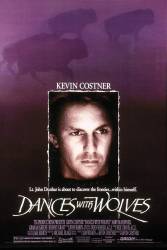Revealing mistake: In the extended version of the film during the buffalo hunt, there is a shot of a buffalo making a turn and in the distant horizon, you can briefly see a modern radio tower on top of a hill.
Continuity mistake: When Kevin Costner gets hit on the head by the top frame of the door, he is knocked out unconscious. Yet, when he gets back up after regaining consciousness, the blood from is head had been running down his nose. Don't you think that as he was lying down in a horizontal position, the blood would run down over the eyes towards the ears?
Continuity mistake: The piece of meat that Dunbar offers the wolf changes shape and size dramatically throughout that scene.
Continuity mistake: Dunbar's jacket has yellow officer tabs on the sholder for Cavalry, but after he gave it to Wind in His Hair, the officer tabs are now blue for Infantry.
Factual error: The Henry Repeating Rifle seen in 1865 is impossible, because it's the "King's Patent Henry Rifle" which wasn't out until 1866. The original Henry had a loading tube under the barrel, not one on the side of the breech. Plus the ammo used is the larger, more modern rounds.
Continuity mistake: When the Sioux men come to steal Dunbar's horse, Dunbar jumps into waist-deep water as he runs toward the corral. As soon as he climbs the river bank, his pants are dry.
Continuity mistake: When Cisco comes to Dunbar on the morning after the hunt, Cisco's "US" brand is missing.
Factual error: When Lt. Dunbar is preparing for his meeting with the Indians, you can see the rubber sole of his boot as he is putting it on. There is also a stamped logo on the boot heel. Rubber bottomed boots did not exist during the Civil War.
Suggested correction: True enough officially, but it often happened during war or in remote areas or in this case Both, unconvential materials would be used in improvised solutions.
Revealing mistake: During the buffalo hunt, where the buffalo turns to charge the fallen Indian, the buffalo has a nose ring used for leading domestic animals.
Factual error: We see and hear geese flying overhead toward the end of the film, a sure sign that winter is approaching, but the birds in the shot are sandhill cranes, which do not "honk" like Canada geese.
Revealing mistake: In the scene where Dunbar comes to the Indian camp with the wounded woman he found, she is supposedly knocked out. However, when the Indian warrior grabs her wrist and pulls her to the tribe, she is also hanging strongly, with her hand around his wrist.
Continuity mistake: At the close of the buffalo hunt, Wind in his Hair cuts out the liver of the buffalo, holding it in two hands. He stands to take a bite out of it and it's already about half its previous size. When he hands it to John Dunbar, it shrinks dramatically in size again, and is a different colour and shape.
Visible crew/equipment: In the scene where the Sioux discover the rotting dead buffalo lying in the valley, as they are riding by them, right after they show a Sioux woman crying, in the background you can see a man with dark hair in a white shirt lying on the ground. In the special edition DVD, if you watch this scene with the commentary on you will hear Kevin Costner and Jim Wilson admit that it is an assistant cameraman trying to get out of the scene. (01:49:55)
Continuity mistake: When Kicking Bird is trying to steal Cisco and Dunbar frightens him away, he falls over the fence. He scares his horse, who runs off to his right. But then Kicking Bird jumps up and runs to his left, and suddenly his horse is waiting for him there, standing still.
Other mistake: Dunbar has to race back to the fort in the middle of having a shave. The amount of soap on his face alters shot to shot.
Revealing mistake: At the end of the movie, just before Dunbar arrives at the winter camp in the mountains, after being rescued by Wind in his Hair and his men, an old Indian man looks up and see them coming down the mountain. The old man is wearing thermal underwear under his leather tunic.
Continuity mistake: When Timmons and Dunbar show up at Fort Sedgewick, Timmons is eating an egg, with only part of an egg on his knife, next shot the egg on his knife is whole. (00:23:25)
Continuity mistake: The buffalo that charges Smiles A Lot is shown on its left hand side, with no arrows. But the shot changes and when the buffalo is shown again, he has 3 arrows stuck in his left side.
Factual error: In an opening scene Kevin Costner is seen eating a Delicious Apple, a variety not created until after the Civil War.
Continuity mistake: After Dunbar and Timmons have arrived at Fort Sedgewick and they realize everyone is gone, after Dunbar says "Not at the moment, we don't know what happened," the shots of Timmons alternate from having no egg on his face to having a lot egg on his face, especially on the tip of his nose. (00:25:30)





